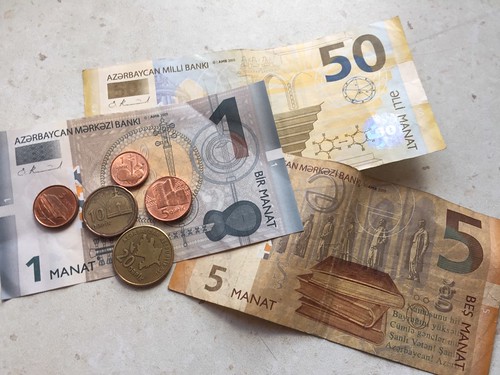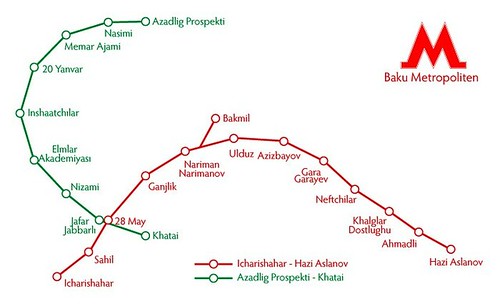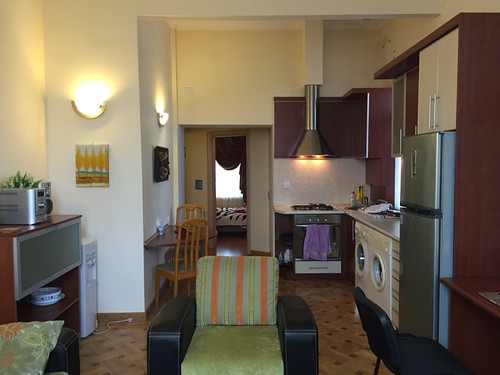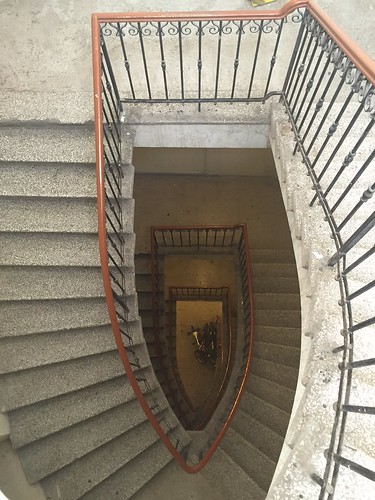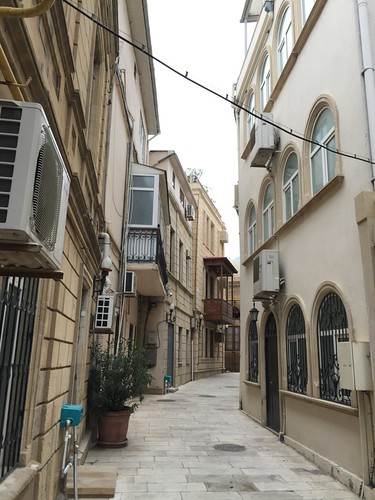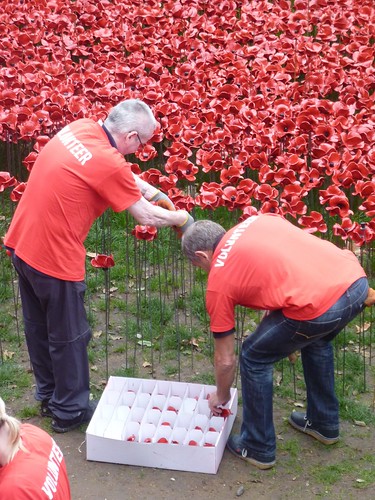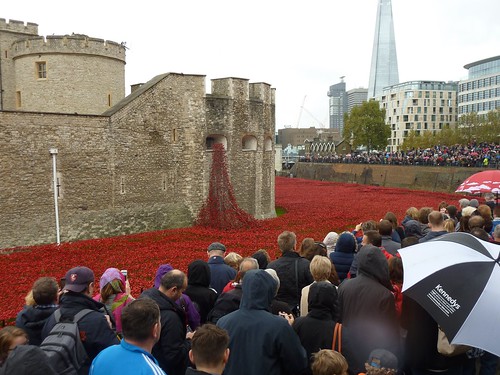It's cheap!
There are a few fun things about the Baku Metro system. The first is the price - a mere 20 qepik per ride, no matter how far you go. (The currency in Azerbaijan is the manat, which is pretty much at par with the euro. One manat is divided into 100 qepik.) As a comparison, for those of you currently living under the yoke of Transport for London, that's 17 pence per ride, as compared to a bare minimum of £1.50 in London (and that's not even addressing the absolutely usurious single ticket price of £4.70, which is NOT a typo). Sure, the London tube system is far far more extensive than the Baku system, but still...
(Aside: Recreational googling reveals this may indeed be the cheapest metro system in the world. Many websites claim Mexico City is cheaper, but at the equivalent of 28 qepik, it still loses out to Baku. Delhi may actually be the winner, with the cheapest fare clocking in at a mere 10 qepik, but they charge more for greater distances. And there’s always the chance that someone will steal your phone.)
It's tuneful!
This is just utterly charming. As in pretty much every metro system everywhere, there are announcements made at each stop along the line. "This is Blah Blah Station." "The doors are closing." "The next station is Blar-de-Blar." "Mind the gap." You know the drill. The same is true here in Baku. When the train arrives at a station, the station name is announced and before leaving the station a woman comes on and says "The doors are closing." and announces the next station. Nothing new there.
So the look and feel of the system is not new to me. What is new is the other thing that happens as the train arrives at a station. Along with a verbal announcement, they play a little tune! Usually it's a few bars of a simple piano piece, but the charming thing is that it's different for every station. So if you pay attention, you could sit with your eyes closed and know when your stop came up by the music that's played. The station at the office - Köroğlu - departs from the usual piano formula with a particularly notable (if horribly distorted) fanfare, which is nice because it's hard to miss. My home station - İçəri Şəhər (EE-chair-ee SHAY-her) - is the last station at the western end of the red line, and its tune is quite mournful. It’s as if the woman playing the piano is heartbroken that the ride is over. This week Gerald set lyrics to the İçəri Şəhər tune that go:
(Incidentally, as further evidence that the Azeri people seem to be generally happier than the Russians, when Gerald and I arrived at the end of the line of Friday and listened to the sad little song, jokingly making sad faces along with it, a young Azeri guy watched us with bemusement, and you could tell he TOTALLY got it. The İçəri Şəhər Sad Song. Nice.)
It's bedevilling!
In my not-inconsiderable experience with underground transport systems of the world, there are a few immutable rules and one of them is this: you can look at a map, figure out which line you’re on (The Green Line, the Victoria Line, Line #2, whatever) and you can be confident that whatever happens, if you stay in your seat, you will remain on the line where you started.
Not so in Baku, though it actually took quite a while for me to figure this out. As you can see from the map above, there is only one interchange station in the system, called 28th May (Named after Republic Day, the national holiday commemorating the founding of the Azerbaijan Democratic Republic in 1918.) Since two lines cross there, I naively assumed that there would be two sets of platforms, one for the red line and one for the green line. And several times I trudged wearily through the marble clad halls of 28th May seeking out the right platform only to find myself directed back to where I started again and again, with increasing consternation. There are large scrolling LED signs at each end of every platform that show the terminus station for trains on that platform, and no matter what I did, I couldn’t find a platform showing the correct terminus for the direction I was heading. Even when I asked local people for help, they kept sending me the wrong way. It seemed almost random when I managed to find a platform displaying the right sign.
Then one day on the way home from work on the red line, I glanced up at the board to see that the sign was displaying the western terminus station for THE GREEN LINE. Whaaaa? There I was, standing in what was indisputably a RED LINE station and yet the next train was going to a GREEN LINE terminus? How could that be?
And then it dawned on me and all became clear, though the realisation was profoundly disturbing. 28th May is an interchange station, but it’s not necessarily the passengers that change there, it’s the TRAINS. Sometimes a train travelling into the station on the red line will leave on the green line. That’s why I couldn’t find any more platforms at 28th May, because I suspect there are only two platforms. That’s also why I had trouble finding the right platform, because when I checked the west-bound platform it had been displaying the green line terminus station, so I assumed I was in the wrong place. Nope. Not the wrong place, just the wrong time. If I’d stuck around, I’d have seen the sign change to show the red line terminus after the green line train passed through.
It was, as I said, profoundly disturbing. Imagine getting on a Victoria Line train in Brixton and ending up in, say, Mile End, because the Victoria Line train changed into a Central Line train as it passed through Oxford Circus. It’s just unnatural. Then again, it’s also sort of diabolically clever because it does eliminate the need to change trains. I suppose when the whole system is complete that sort of thing will become impractical since the myriad combinations of start and end points will get a bit too much to manage.
In any case, I’ve now cracked the mysteries of 28th May Station and the chameleon trains. And while part of me still feels like Baku is breaking a cardinal metro rule, I suppose for 20 qepik I really can’t complain. In any case, it’s a lovely sunny Sunday and the old men are out playing backgammon in Triangle Square (which is what I call the public square outside my apartment because, of course, it’s shaped like a triangle). And there’s just enough time for a quick coffee and a pastry downstairs before the hash. Happy Sunday.
There are a few fun things about the Baku Metro system. The first is the price - a mere 20 qepik per ride, no matter how far you go. (The currency in Azerbaijan is the manat, which is pretty much at par with the euro. One manat is divided into 100 qepik.) As a comparison, for those of you currently living under the yoke of Transport for London, that's 17 pence per ride, as compared to a bare minimum of £1.50 in London (and that's not even addressing the absolutely usurious single ticket price of £4.70, which is NOT a typo). Sure, the London tube system is far far more extensive than the Baku system, but still...
(Aside: Recreational googling reveals this may indeed be the cheapest metro system in the world. Many websites claim Mexico City is cheaper, but at the equivalent of 28 qepik, it still loses out to Baku. Delhi may actually be the winner, with the cheapest fare clocking in at a mere 10 qepik, but they charge more for greater distances. And there’s always the chance that someone will steal your phone.)
Some manat and some qepik. Interestingly, qepik come in coin denominations of 50, 20, 10, 1 and... 3. Weird.
And here's the whole map of the system. Two lines, 23 stations in total. About 35 km of tracks. (London has 270 stations and 402km of track. But then again London's population is between 8 and 13 million, depending on where you draw the lines, whereas Baku is a comfy 2-4 million and there are only 9 million people in the whole country.)
It's tuneful!
This is just utterly charming. As in pretty much every metro system everywhere, there are announcements made at each stop along the line. "This is Blah Blah Station." "The doors are closing." "The next station is Blar-de-Blar." "Mind the gap." You know the drill. The same is true here in Baku. When the train arrives at a station, the station name is announced and before leaving the station a woman comes on and says "The doors are closing." and announces the next station. Nothing new there.
Construction of the system was a started in 1967 under Soviet rule, so it's very very very much like the Moscow Metro. Very deep stations, very long escalators, and very nice decor.
True, it's not exactly Sondheim, but I will never again arrive at the station again without hearing those words in my head.I'm so sad,You're so sad,Now it's done,Go a-way.
(Incidentally, as further evidence that the Azeri people seem to be generally happier than the Russians, when Gerald and I arrived at the end of the line of Friday and listened to the sad little song, jokingly making sad faces along with it, a young Azeri guy watched us with bemusement, and you could tell he TOTALLY got it. The İçəri Şəhər Sad Song. Nice.)
It's bedevilling!
In my not-inconsiderable experience with underground transport systems of the world, there are a few immutable rules and one of them is this: you can look at a map, figure out which line you’re on (The Green Line, the Victoria Line, Line #2, whatever) and you can be confident that whatever happens, if you stay in your seat, you will remain on the line where you started.
Not so in Baku, though it actually took quite a while for me to figure this out. As you can see from the map above, there is only one interchange station in the system, called 28th May (Named after Republic Day, the national holiday commemorating the founding of the Azerbaijan Democratic Republic in 1918.) Since two lines cross there, I naively assumed that there would be two sets of platforms, one for the red line and one for the green line. And several times I trudged wearily through the marble clad halls of 28th May seeking out the right platform only to find myself directed back to where I started again and again, with increasing consternation. There are large scrolling LED signs at each end of every platform that show the terminus station for trains on that platform, and no matter what I did, I couldn’t find a platform showing the correct terminus for the direction I was heading. Even when I asked local people for help, they kept sending me the wrong way. It seemed almost random when I managed to find a platform displaying the right sign.
Then one day on the way home from work on the red line, I glanced up at the board to see that the sign was displaying the western terminus station for THE GREEN LINE. Whaaaa? There I was, standing in what was indisputably a RED LINE station and yet the next train was going to a GREEN LINE terminus? How could that be?
And then it dawned on me and all became clear, though the realisation was profoundly disturbing. 28th May is an interchange station, but it’s not necessarily the passengers that change there, it’s the TRAINS. Sometimes a train travelling into the station on the red line will leave on the green line. That’s why I couldn’t find any more platforms at 28th May, because I suspect there are only two platforms. That’s also why I had trouble finding the right platform, because when I checked the west-bound platform it had been displaying the green line terminus station, so I assumed I was in the wrong place. Nope. Not the wrong place, just the wrong time. If I’d stuck around, I’d have seen the sign change to show the red line terminus after the green line train passed through.
It was, as I said, profoundly disturbing. Imagine getting on a Victoria Line train in Brixton and ending up in, say, Mile End, because the Victoria Line train changed into a Central Line train as it passed through Oxford Circus. It’s just unnatural. Then again, it’s also sort of diabolically clever because it does eliminate the need to change trains. I suppose when the whole system is complete that sort of thing will become impractical since the myriad combinations of start and end points will get a bit too much to manage.
You see this map a lot in the train cars themselves. It's sort of an aspirational version of the metro map showing what I presume is the intended expansion of the current system. By the time they finish all this maybe they'll jack the price up to 25 qepik.
Triangle Square on a sunny Sunday

